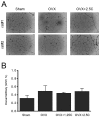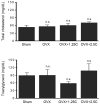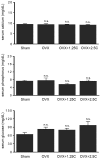Amelioration of estrogen deficiency-induced obesity by collagen hydrolysate
- PMID: 27877077
- PMCID: PMC5118756
- DOI: 10.7150/ijms.16706
Amelioration of estrogen deficiency-induced obesity by collagen hydrolysate
Abstract
Objectives: Menopausal transition with declining estrogen levels significantly affects the physiological properties of women and consequently contributes to a series of medical conditions, including obesity. Obesity is a crucial risk factor associated with cardiovascular diseases, diabetes mellitus, and breast cancer. Increasing dietary protein content improves satiety and energy expenditure. Thus, we hypothesize that supplementing with collagen, a common dietary protein, may alleviate menopause-induced obesity. Methods: We used ovariectomized (OVX) rats to mimic a menopausal human. The body weight of OVX rats significantly increased compared with that of sham-operated rats (P<0.05), but uterus weight was decreased. Adipocyte size in perigonadal adipose tissue also increased (P<0.05). Results: By contrast, OVX rats supplemented with aqueous collagen hydrolysate (2.5 mg/mL) exhibited significant attenuation in body weight gain and adipocyte enlargement (P<0.05), but insignificant change in uterus weight. Further investigation indicated that collagen hydrolysate supplementation insignificantly affected the levels of dorsal fat, serum total cholesterol, and serum triacylglycerol. Levels of serum biochemical factors, calcium, phosphorus, and glucose were also insignificantly altered by collagen hydrolysate supplementation. Conclusion: Collagen hydrolysate supplementation reduced body weight gain and adipocyte enlargement in response to ovariectomy but slightly affected blood lipids, calcium, and glucose in both sham-operated and OVX rats. Collagen hydrolysate supplementation is beneficial in ameliorating estrogen deficiency-induced obesity and its associated risk factors.
Keywords: Collagen; Obesity; estrogen deficiency.
Conflict of interest statement
The authors have declared that no competing interest exists.
Figures




References
-
- Poehlman ET, Goran MI, Gardner AW. et al. Determinants of decline in resting metabolic rate in aging females. The American journal of physiology. 1993;264:E450–455. - PubMed
-
- Kritz-Silverstein D, Barrett-Connor E. Long-term postmenopausal hormone use, obesity, and fat distribution in older women. JAMA: the journal of the american medical association. 1996;275(1):46–49. - PubMed
-
- Shinoda M, Latour MG, Lavoie JM. Effects of physical training on body composition and organ weights in ovariectomized and hyperestrogenic rats. International journal of obesity and related metabolic disorders: journal of the International Association for the Study of Obesity. 2002;26(3):335–343. - PubMed
-
- Jensen LB, Vestergaard P, Hermann AP. et al. Hormone replacement therapy dissociates fat mass and bone mass, and tends to reduce weight gain in early postmenopausal women: a randomized controlled 5-year clinical trial of the Danish Osteoporosis Prevention Study. Journal of bone and mineral research: the official journal of the American Society for Bone and Mineral Research. 2003;18(2):333–342. - PubMed
-
- Mastorakos G, Valsamakis G, Paltoglou G, Creatsas G. Management of obesity in menopause: diet, exercise, pharmacotherapy and bariatric surgery. Maturitas. 2010;65(3):219–224. - PubMed
MeSH terms
Substances
LinkOut - more resources
Full Text Sources
Other Literature Sources
Medical

